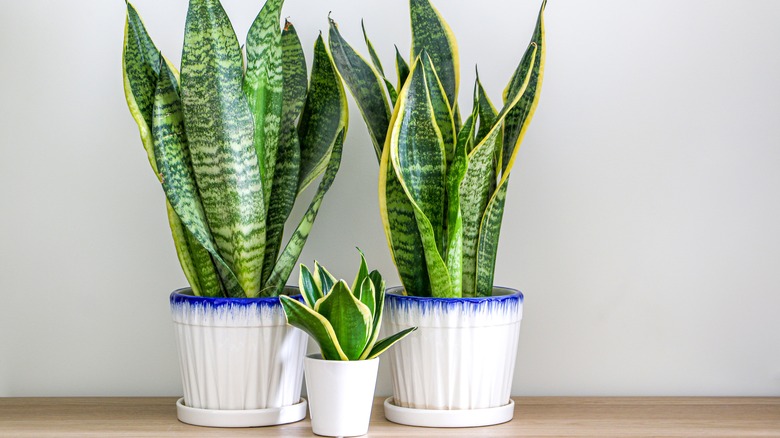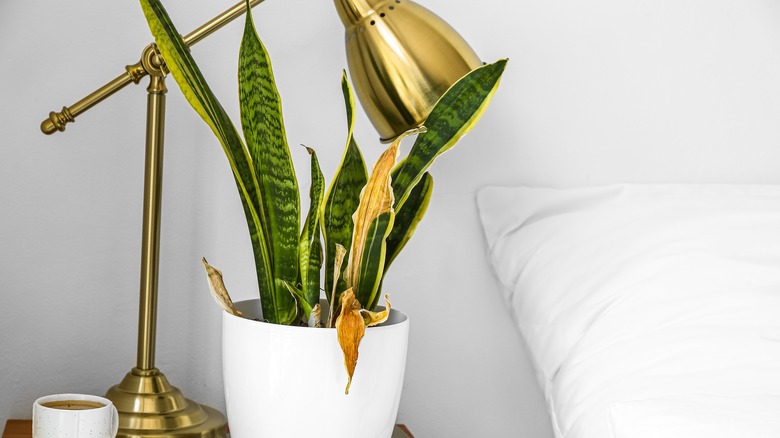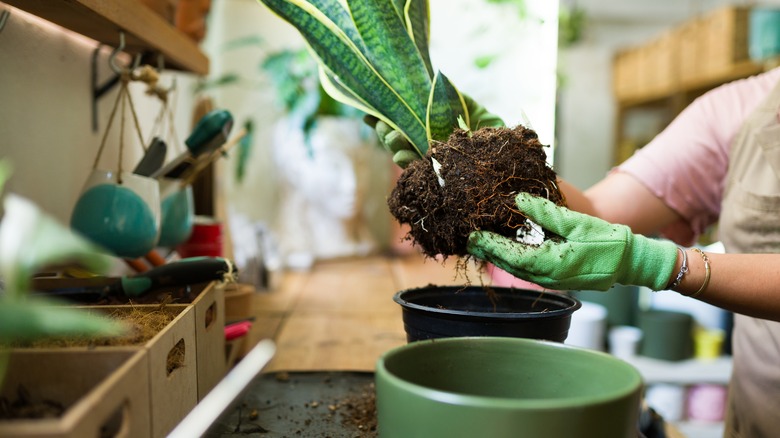Signs That It's Time To Repot Your Trusty Snake Plant (And How To Do It Best)
We may receive a commission on purchases made from links.
When it comes to the most popular house plants, snake plants sit right at the top of the charts along with other heavy hitters, like a string of pearls, monsteras, and philodendrons. It's easy to see why snake plants are so popular, too — they're a durable houseplant you can grow in low light and require very little water. Even with their reputation for being virtually unkillable, snake plants still need to be repotted from time to time to keep the plant healthy, albeit much less frequently than other houseplants. Basically, if it's been more than three years, or your snake plant is showing obvious signs of distress like yellowing leaves or a lack of growth, it's probably time to give your beloved houseplant a slightly larger home with fresh soil.
Essentially, all you'll need is a pot a few inches larger than its original, a knife to clean up the roots, and some fresh soil, and you'll be golden. With that said, if you want your snake plant to truly thrive once it's been repotted, there are a few extra steps you can take to really care for your houseplant.
Indications your snake plant needs a new pot
Snake plants are incredibly easy to care for, but that doesn't mean they can live forever in the same pot. If the soil appears dried out and nutrient-deficient and the water goes straight through the soil every time you water, it's most definitely time to repot.
Snake plants have very strong roots, and when your plant starts to outgrow its pot, the roots might actually split or crack the pot open! If this happens, it's definitely time to get your plant a new home. Another sign your snake plant needs to be repotted is if its growth has been halted. Healthy and happy indoor snake plants can grow about one foot per year, and if you're seeing significantly less growth than this, it might be time to repot. Physical signs like droopy, wilting, or yellow leaves, smelly soil, or an extremely overcrowded pot filled with pups are all telltale signs your snake plant might be in trouble and in need of a new pot. In addition to repotting, you can also propagate your snake plant if it has a lot of pups. Not only will your original plant have more space to grow, but you'll accumulate some new house plants in the process!
How to repot your snake plant correctly
Snake plants are technically succulents and need very little water. They also like to completely dry out between waterings, so the soil type you choose is very important. A mix of cactus soil and houseplant soil should work well for your snake plant, or you can also try using succulent soil. To prevent root rot, the new pot should only be 2 inches wider than the previous one.
Once you have your pot and soil all settled, you can begin the fun part — actually repotting your snake plant! First, you can gently remove your snake plant from its original soil. To keep all the leaves together, you can either attempt to wrangle them by hand or try this TikTok hack for repotting snake plants that uses a silky ribbon to keep the leaves together. Once you have lifted the plant from the soil, you can lightly shake any old soil off and inspect the roots. If they're black and mushy, you can give them a light trim with a knife or some gardening shears. You'll also want to cut the roots a little loose if they're wound into a tight-knotted ball to allow optimal growth. After the roots look good, you can set the snake plant into its new pot with fresh soil. Add a little more soil to be sure the roots are fully covered, and give the soil a gentle pat to remove air pockets. To give your snake plant some time to settle into its new pot and avoid transplant shock, wait a couple of days before watering.


